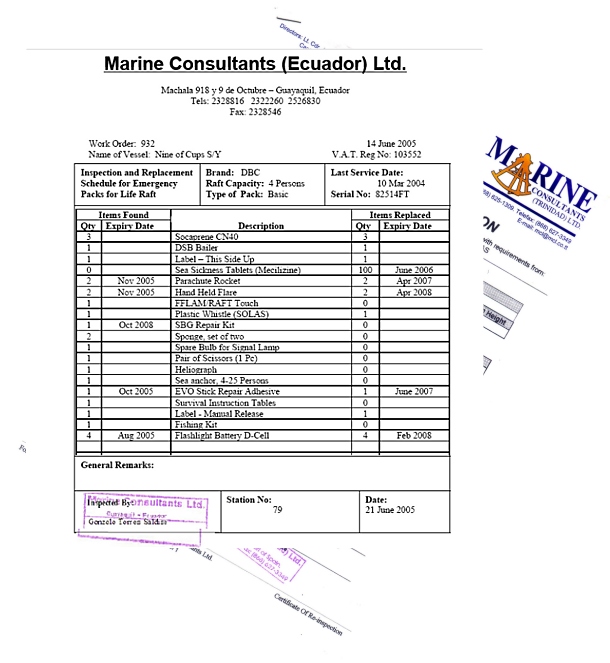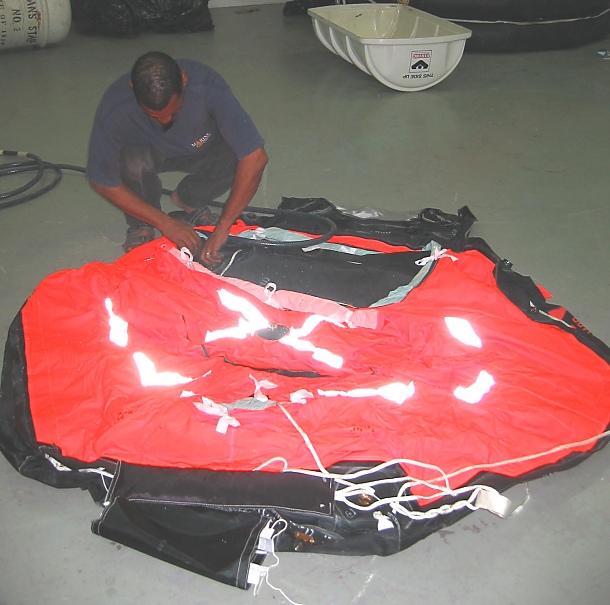The Blue View - Life Rafts
/We have a lot of gear aboard that we have never used. Some was purchased because we thought it was a good idea at the time, but turned out to be things we didn't need. Some of it was purchased as spares and are good things to have aboard but haven't been used yet. And some are for last resort emergencies that we hope we never to have to use.
Our life raft falls into the last category. It is a four person, offshore rated life raft that is housed in a canister, and is secured to a cradle on deck. The life raft has a 30' painter that secures it to Nine of Cups. Most of the painter is tucked away inside the sealed canister. If we should ever need to deploy it, the process is to pull out 20 or so feet of the painter. The webbing that holds the life raft in its cradle is held in place with a quick release pelican hook, and this is opened. The entire canister is then picked up and thrown overboard. Once it is in the water, the remaining painter is pulled out of the canister. The painter not only attaches the life raft to the boat, but also triggers a CO2 tank that inflates the buoyancy tubes on the raft. The expanding tubes exert enough pressure to force the canister open. The canister sinks or floats away and the life raft is left floating at the end of the painter. The life raft isn't actually boarded and cut loose until there is no hope for Cups. There is an old adage that states that it's not time to move to the life raft until you need to step up to it.
Our life raft spends 98.6% of its life inside the canister on deck. During the other 1.4% of the time, it gets treated to an annual trip off the boat to get inspected, resupplied and repacked. Since all ships carry life rafts that must be inspected annually, we have rarely been in a port that didn't have one or more companies that provided this service. It is not cheap – the basic inspection usually runs between $100 - $200. There is almost always something that needs replacing, however, like flares or gaskets or the patch kit, and it always seems to end up costing closer to $500 each year. Some of the newer life rafts only need to be inspected every three years, and would save a lot of money over the usual 10 or 12 year lifetime of the life raft.
Another way to save money is to provide the items we want to replace or update to the company doing the inspection. We have our own seasickness meds, for example, and the inspection company is usually amenable to letting us provide them instead of selling us some very expensive alternatives. On completion of the inspection, we are given a list of everything in the life raft and its expiration date. We always review the previous year's list so we know what will reach its expiration soon, and we provide replacements for what we can when we deliver the life raft. We have been able to provide food rations, meds, and the occasional replacement part for considerably less money than we would have been charged by the inspection company. We don't cut corners, however. Saving five dollars on a patch kit that may or may not adhere to the life raft fabric is pretty foolish.
As part of the inspection, the life raft is inflated with room air, and left inflated for a day to check for leaks and to let the fabric stretch out. The flares are checked and replaced as needed, and everything is inspected. While the process can be done in two days, we usually ask that it be left inflated for a few more days.
We try to visit our life raft while it is inflated. Most people never see this important survival gear deployed and inflated until it is needed in an emergency. We like to reacquaint ourselves with it each year. We check out all the gadgets it has, like the sea anchor, signal mirror, and flares, and how they are used. We climb inside and figure out how best to board it when we are soaking wet, wearing foul weather gear and PFDs. We sit in it for a few minutes and imagine how it would be to live in it for a few weeks - and what we would need to survive. Then it is repacked and sealed back in its canister, and we return it to its home on the deck.
The survival gear that is kept in the life raft is pretty minimal. We keep a Ditch Bag on board that has the majority of the things we would need to stay alive in the life raft until we were, hopefully, either rescued or made landfall. We used to keep more gear in the life raft, but since we can only access it during the annual inspection, it is difficult to service, inspect and update the gear and supplies ourselves. For those that are interested, I plan to devote a Blue View on our Ditch Bag in the near future.
We have four friends that were saved by their life rafts. One couple hit a rock off New Zealand, and their sailboat sunk in just a few minutes. Another boat was holed by a whale, and one suffered major damage after a propane explosion in the galley. The fourth vessel had a petroleum fire aboard, and while the steel vessel did not sink, the crew could not remain aboard. We hope not to join this elite group, but having the life raft on board is good security – just in case.





